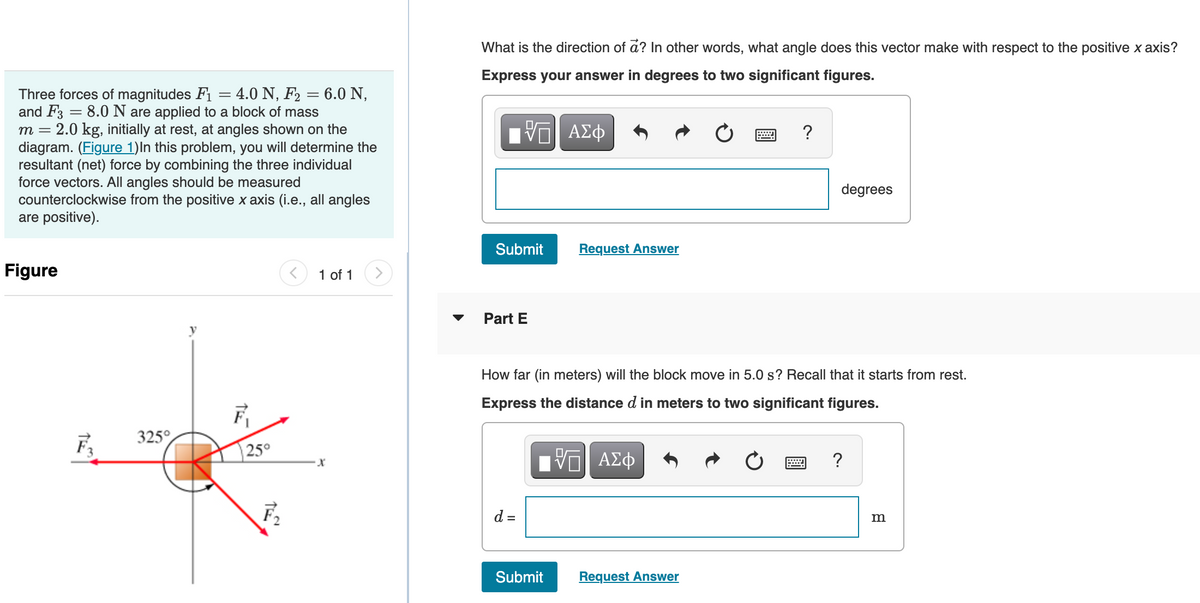Three forces of magnitudes F₁ = 4.0 N, F₂ = 6.0 N, and F3 = 8.0 N are applied to a block of mass m = 2.0 kg, initially at rest, at angles shown on the diagram. (Figure 1) In this problem, you will determine the resultant (net) force by combining the three individual force vectors. All angles should be measured counterclockwise from the positive x axis (i.e., all angles are positive). Figure 1 of 1 your answer in deg Part E Π| ΑΣΦ Submit Request Answer Signincant gares. ? degrees How far (in meters) will the block move in 5.0 s? Recall that it starts from rest. Express the distance d in meters to two significant figures.
Three forces of magnitudes F₁ = 4.0 N, F₂ = 6.0 N, and F3 = 8.0 N are applied to a block of mass m = 2.0 kg, initially at rest, at angles shown on the diagram. (Figure 1) In this problem, you will determine the resultant (net) force by combining the three individual force vectors. All angles should be measured counterclockwise from the positive x axis (i.e., all angles are positive). Figure 1 of 1 your answer in deg Part E Π| ΑΣΦ Submit Request Answer Signincant gares. ? degrees How far (in meters) will the block move in 5.0 s? Recall that it starts from rest. Express the distance d in meters to two significant figures.
University Physics Volume 1
18th Edition
ISBN:9781938168277
Author:William Moebs, Samuel J. Ling, Jeff Sanny
Publisher:William Moebs, Samuel J. Ling, Jeff Sanny
Chapter6: Applications Of Newton's Laws
Section: Chapter Questions
Problem 53P: Show that the acceleration of any object down an incline where friction behaves simply (that Is,...
Related questions
Question

Transcribed Image Text:Three forces of magnitudes F₁ = 4.0 N, F₂ = 6.0 N,
and F3 = 8.0 N are applied to a block of mass
=
m = 2.0 kg, initially at rest, at angles shown on the
diagram. (Figure 1) In this problem, you will determine the
resultant (net) force by combining the three individual
force vectors. All angles should be measured
counterclockwise from the positive x axis (i.e., all angles
are positive).
Figure
325°
F₁
25°
F₂
1 of 1
X
What is the direction of a? In other words, what angle does this vector make with respect to the positive x axis?
Express your answer in degrees to two significant figures.
——| ΑΣΦ
Submit
Part E
d =
Request Answer
Submit
=
How far (in meters) will the block move in 5.0 s? Recall that it starts from rest.
Express the distance d in meters to two significant figures.
ΠΙ ΑΣΦ
Request Answer
?
degrees
?
m
Expert Solution
This question has been solved!
Explore an expertly crafted, step-by-step solution for a thorough understanding of key concepts.
This is a popular solution!
Trending now
This is a popular solution!
Step by step
Solved in 2 steps with 1 images

Knowledge Booster
Learn more about
Need a deep-dive on the concept behind this application? Look no further. Learn more about this topic, physics and related others by exploring similar questions and additional content below.Recommended textbooks for you

University Physics Volume 1
Physics
ISBN:
9781938168277
Author:
William Moebs, Samuel J. Ling, Jeff Sanny
Publisher:
OpenStax - Rice University

Physics for Scientists and Engineers: Foundations…
Physics
ISBN:
9781133939146
Author:
Katz, Debora M.
Publisher:
Cengage Learning

University Physics Volume 1
Physics
ISBN:
9781938168277
Author:
William Moebs, Samuel J. Ling, Jeff Sanny
Publisher:
OpenStax - Rice University

Physics for Scientists and Engineers: Foundations…
Physics
ISBN:
9781133939146
Author:
Katz, Debora M.
Publisher:
Cengage Learning